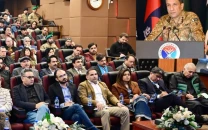The need to invest in women's mobility
Social norms and safety concerns restrict the movement of women

Women in Pakistan's urban areas face daily struggles just to move around. In Lahore, Karachi and Islamabad, a lack of safe and affordable public transport constrains women's mobility and limits their education and job opportunities. While "pink" women-only buses have been introduced, empowerment will require a more profound rethinking of the entire "mobility ecosystem" in the city.
Social norms and safety concerns restrict the movement of women. Most are afraid to travel on crowded buses and vans where hardly a seat is kept for women. As of the 2014 Asian Development Bank report, 70% of Pakistani women have been sexually harassed on public transport. Approximately 31% of female students and 23% of working women reduce the use of public transport after harassment. Most women travel with a male relative or avoid traveling at night, which is a hindrance to pursuing evening classes or employment.
The effect on work and education is of greatest importance. In Pakistan, working women number approximately 21%, the lowest in South Asia. In urban Sindh, a mere 11% in 2021. A lack of secure and safe transport is a significant problem. In one survey, 75% of women in Lahore said they would work if they had safe transport. In education, 40% of the women do not venture out after dark, decreasing their chances to further their studies or training.
Personal accounts make clear what is at stake. Samaria Khan, a young mother in Hyderabad, traveled six hours a day to Karachi for a training course for women bus drivers - a scarce chance at a more secure life. Kiran, a second year student, said the programme "totally changed my life". A student in Punjab's Women on Wheels motorbike programme described her new freedom to travel to college without the need for a bus or family.
The authorities have now taken measures to address these concerns. Pink Bus service is now operational in Karachi, Lahore, Islamabad, Rawalpindi and Multan, offering transport only to women during peak hours. Islamabad introduced 20 pink buses on 10 routes between suburbs and workplaces and schools in the mid-2024. Passengers welcome the safety and courtesy they provide but continue to complain about inadequate buses and an over-demand. Women's safety can be enhanced in all public transport and not just in segregated services by providing better lighting, CCTV cameras and trained personnel.
The Women on Wheels initiative provides discounts on scooters to women, with a target of reaching 22,000 women in Pakistan. Women have been learning to drive motorcycles in Punjab since 2016. Karachi's Yellow Line Bus Rapid Transit system is also ensuring women's participation in planning, with 30% of its 650 new drivers being women and the stations being made safer.
Grassroots efforts are helping in substantial ways. Women on Wheels motorbike schools teach women to ride motorbikes, giving them skills, confidence and independence. The Pink Rickshaw programme in Lahore hires female drivers to carry female passengers. Startups like Islamabad's SheKab offer women-only carpools with trusted drivers, and Karachi's Roshni Rides offers low-cost van rides for low- and middle-income women. They help those who feel unsafe on the bus but cannot afford daily ride-hailing, reducing fear and making it easier for them to commute to work and school.
Rebuilding women's mobility takes more than discrete projects. It takes more accessible and secure public space and transport for all women and affordable to low-income riders. It takes building out transit corridors, improving first-and-last mile connections, implementing zero-tolerance for harassment and engaging women in transport planning. Public-private partnerships and community-based services can meet short-term needs while sustainabile reforms take hold. When women can travel freely, they like going to school, working or doing traditionally men's jobs, like driving a bus.
The future of Pakistan's cities depends on women being able to travel freely and on their own. Beyond the pink buses, there is a dream of cities where it is normal for a woman to board a bus or drive a scooter, and everyone is able to move. It is a task that requires constant effort, but enabling half of the population has social and economic dividends that make it worthwhile.

















COMMENTS
Comments are moderated and generally will be posted if they are on-topic and not abusive.
For more information, please see our Comments FAQ